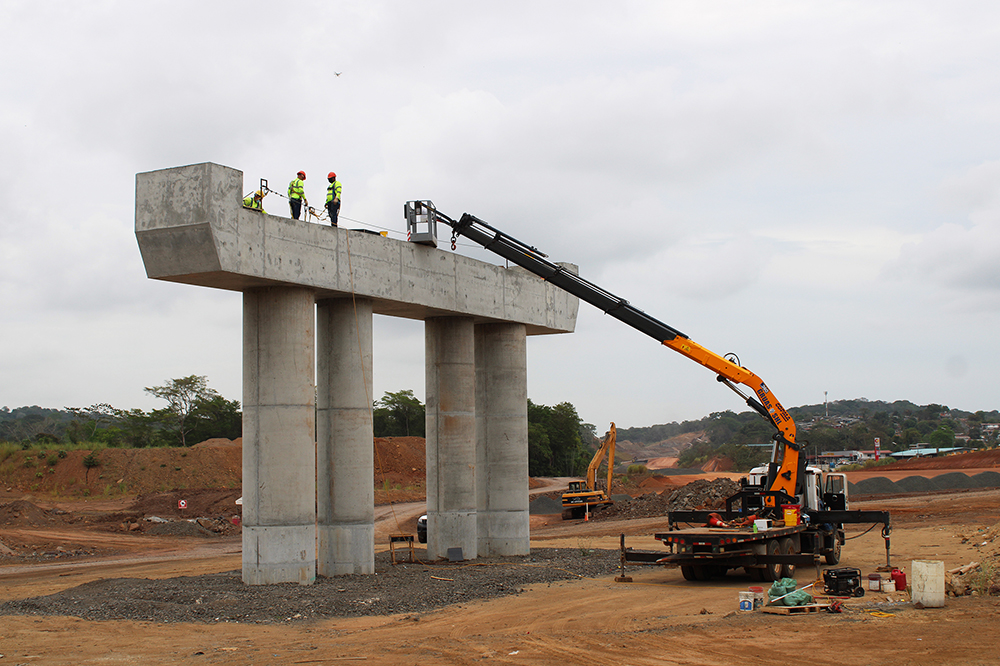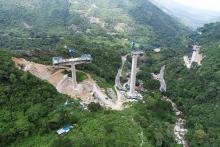
With the construction of the Panamericana Oeste highway, the Government of Panama intends to ensure the country’s economic development over the next 20 years. The project will benefit the inhabitants of Panama West by reducing journey times from two hours to 45 minutes. Furthermore, this extension will guarantee the connection to the fourth bridge over the Panama Canal and will complement the capacity of Line 3 of the Metro, benefiting 600,000 inhabitants. According to the latest data from the Ministry of Public Works (MOP), the project is around 75% complete at present.
Of the different proposals presented in the tender, the Loma-Cová consortium, comprising the Spanish company Acciona Infraestructura and the Costa Rican company Meco Constructora, was awarded the package of works.
In general, the project consists of the rebuilding of 11km of the Pan-American Highway, widening the route from four to eight lanes. The rebuilt stretch will feature three permanent lanes in either direction as well as a central roadway with two lanes that will be reversible to cope with varying traffic needs in peak hours. In addition, the project will include the construction of five new interchanges.

In the original specifications prepared by the MOP, the reversible two-lane central roadway was intended to operate in the Arraiján - Panama direction during morning rush hours, and in the Panama - Arraiján direction during evening rush hours. Depending on demand, the reversible lanes can also be adapted to the most convenient direction to suit traffic requirements. The stretch being widened runs from the connection with the project of the fourth Bridge over the Panama Canal (in the Cocolí area) to the connection with the Centenario road (in the Burunga area), where a new road interchange is also being built.
The extension of the highway to eight lanes from Loma Cobá will also allow an improvement in the gradient, limiting the slope to 6%. The new stretch will be independent from the current highway through a new layout until its final connection with the Centenario highway.
The construction work for this highway expansion project commenced some 500m from the existing Howard/Cocolí interchange, and continued along the current corridor of the Pan-American Highway until it passed Loma Cobá, and from there was routed to the North in a new alignment (bypass section), finally connecting with the Centenario road in Burunga.
In addition to the widening work for the highway itself, the project also includes the construction of six road interchanges, four box-type road structures, 13 bridges and a pedestrian walkway. The work being carried out also includes new cross drainage structures, cross drainage works with concrete pipes, the relocation of 16km of oil pipeline, building 5km of aqueducts, installing 10km of telecommunications lines and 16km of power lines. Conditioning factors that both in the design phase and in the construction of the works were difficult to execute.
The new alignment for the road runs parallel with the existing road from Loma Cová for approximately 2km until it reaches kilometre point 7. From this section, very close to Arraiján, the route runs for around 1km through a wooded area until it connects with the Centenario road to the north of the current Burunga junction. As a consequence of the adaptation of the existing road system to the new high capacity infrastructure, the Centenario road is extended to three lanes in each direction for a distance of around 2km. A necessary component of the project has been to replace the three existing road bridges that cross it. These are the bridges at Burunga (structure E-10), the bridge linking with the current highway and the Centenario road (structure E-11) and the bridge for the old Pan-American Highway (structure E-12).
The new, widened road is designed to allow vehicle speeds of 100km/h. The project will relieve current traffic problems by providing sufficient capacity to cope with the expected increase in the number of vehicles using the route. The traffic projections for the road have been determined by Panama’s Transit and Land Transportation Authority, covering the next 20 years.

(image courtesy of Public Works Ministry of Panama (MOP))
Surfacing
To cope with the heavy traffic volumes expected, the structure of the pavement has been specially selected. The asphalt mix design used will allow better performance and durability. The quality of the mix was assured during production and strict controls were applied in the construction phase to guarantee a longer working life and high load capacity.
The friction course has a thickness of 30mm and is designed to allow rapid and adequate drainage of the surface in order to avoid accumulations of water that could cause vehicles to aquaplane in heavy rain. The road pavement thus formed has a medium void content, so that it provides the high permeability required and, additionally, a reduction in noise levels.
Bridges
The 11 bridges and viaducts provide road crossings at different levels. For the most part, they are bridges with decks of post-tensioned precast beams, reaching spans of up to 41m.
Fromthe beginning of the design phase for this mega project, the engineering team from the Spanish construction company Acciona Infraestructura used different criteria to establish the types and sizes of bridges that would be required. The firm has strict criteria to work to so as to meet the requirements set by the MOP. One notable challenge was that the contractor could not impede traffic flow on the existing Pan-American Highway during the construction phase.
For the design of the bridges, the engineers had to avoid the use of falsework for the execution of the in situ decks. Instead, the firm opted to build structures made up of precast elements as this would be quicker to build and pose less of an impact on traffic flow along the route.
The high seismic risk was another important factor that was considered during the design phase. To meet this challenge, the design team ensured all structures met with Panama’s new REP-14 technical regulations. This ensured the various construction parameters were carried out in accordance with the seismic maps of the area.
Finally, the third determining factor that the engineers had to consider along the route of the highway was the low bearing capacity of the ground. This required the construction of deep foundations for almost all of the bridge structures.
An in-depth geotechnical study of the area had been carried out prior to the design and construction work, providing key information. To ensure that the foundation work would meet requirements, the Cross Hole Sonic Logging (CHSL) method was used during construction. This CHSL method was carried out to the ASTM D6760 “Standard Test Method for Integrity Testing of Concrete Deep Foundations by Ultrasonic Crosshole Testing”. This ensured control of concrete quality through the use of ultrasonic testing of the reinforced concrete piles. And with the use of prefabricated elements that were self-supporting, the use of falsework was not required.
For most of the bridges, the engineers used structures featuring precast isostatic decks and foundations based on pile caps. Neoprene was utilised under each beam to act as support elements for the decks.

Ground conditions
The geophysical studies carried out by the contractor companies played a decisive role with respect to the design of the structures in relation to the seismic action of the place and to adapt the possible solutions according to the means and construction customs of the country.
According to the data collected, different alternatives were proposed, including a system using high damping neoprenes (HDRB) that allow the isolation of the structure due to its high deformation capacity. However, this option was ruled out due to the level of flexibility of the ground and of the foundations that would prevent the neoprene from reaching its maximum range of deformation and therefore not being effective.
Instead a series of conventional neoprene supports with anchors were used on the viaduct. These provide vertical rigidity and longitudinal deformation capacity. And transversely, they were placed as seismic stops at the ends of the abutment and pier braces.
This methodology was applied to the E11 structure, where the best option was the use of energy dissipation, forcing the engineers to design deep foundations, which in the case of the E11 structure turned out to be very flexible.
The solution based on the use of this method ensured a reduction of possible seismic forces and material savings. It is of note though that this solution results in a greater construction complexity with the execution of the heavy struts “in situ”.
The lanes are 3.65m wide and were designed according to AASTHO standards using a Superpave type asphalt pavement. This asphalt mix design is expected to allow better performance, durability and quality and was produced in accordance with strict technical controls. This will ensure a road with a longer useful life and greater load support. Meanwhile the connecting links and the associated roads are being designed with rigid hydraulic concrete pavement with a thickness of 300mm on a granular sub-base of 1m thickness.
To help optimise safety for road users, rigid side barriers with the proven New Jersey profile provide separation with the main roads.
A longitudinal drainage system is installed to collect and channel rainwater from the road. Water that filters under the surface passes through a network of curbs-gutters with internal widths that vary from 30-150cm and are connected to cross tubes of 60-80cm in diameter. For the collector roads the water is channelled through trapezoidal ditches. For the transversal drainage system, a tubular sewer network has been installed that varies from 100-190mm in diameter and utilises box type sewers of different dimensions.
The interchanges play a key role for the new road connection as these will provide greater fluidity and interconnection for the drivers.
Interchange 1, Howard/Cocolí, allows the Arraijan-Panama direction change and vice versa. It also provides access to a future station for the planned Line 3 of the Panama Metro.
The lower part of the structure utilises a steel frame and the concrete slab rests on the transverse precast beams. To complete the structure a transversal drainage system was built, consisting of five single and double rainwater caissons, as well as five lines of reinforced concrete pipes of 1.8m in diameter.
Interchange 2 is the Panama Pacifico access link and is made up of main roads and a reversible central road.
Interchange 3 is a link that will connect the current highway with the new highway in the Loma Cobá area and will also provide access to a future station for the planned Line 3 of the Panama Metro.
Interchange 4 will connect via Centenario with the new highway in the Burunga area.
Interchange 5 provides the access from the Centenario highway and the existing Inter-American highway in the town of Burunga.
Finally, interchange 6 is the link located in sector 7 De Septiembre, located 1.2km west of Interchange 3.











